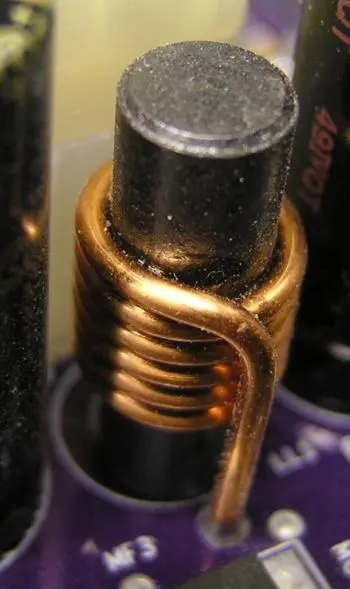
Inductors, often overlooked compared to other electronic components such as resistors and capacitors, play a critical role in a wide range of electronic applications.
Their ability to store energy in the form of a magnetic field and their resistance to changes in electrical current make them essential components in the design and operation of electronic circuits.
In this article, we will explain what inductors are, how they work and what their key applications are in the world of electronics, highlighting their importance in modern industry and technology.
What is an inductor?
An inductor is a passive component that stores energy in the form of a magnetic field when an electric current passes through it.
It consists of a coil of wire wound around a core, which can be made of materials such as iron, ferrite or air. The fundamental property of an inductor is its ability to resist changes in the current passing through it.
The greater the inductance of an inductor, the more resistance it offers to the change in current.
Operating principle
The principle of operation of an inductor is based on Faraday's law of electromagnetic induction.
When an electric current flows through the coil of wire, a magnetic field is generated around the inductor. If the current changes, either increasing or decreasing, the magnetic field also changes. This change in the magnetic field induces an electromotive force (EMF) in the coil, which opposes the change in current according to Lenz's law.
Inductor Applications
Inductors are used in a wide variety of applications in electronics. Some of the most common applications include:
-
Power Supplies: Inductors are used in power supply switching circuits to filter noise and stabilize voltage output.
-
Filters: Used in combination with capacitors to create passive filters that can attenuate or eliminate certain frequencies in an electrical signal.
-
Antennas: In communication systems, inductors are used in antennas to tune the transmit and receive frequency.
-
DC-DC Converters: In power conversion applications such as DC-DC converters, inductors play a crucial role in energy regulation and efficiency.
-
Oscillator circuits: These elements are used in the construction of oscillators that generate constant frequency signals, such as in electronic watches and radios.
-
Energy Storage: These devices can be used in energy storage systems, such as battery charging and discharging systems.
Use in solar energy systems
Inductors have a significant relationship with solar energy in photovoltaic systems.
They are used in solar inverters to convert the direct current (DC) generated in photovoltaic panels into alternating current (AC) and stabilize the energy produced. Additionally, they play a role in current and voltage regulation, solar tracking systems, voltage stabilization and power quality management by helping to filter noise and control fluctuations in solar generation.
These devices are also essential in the charging and discharging of solar batteries and in energy storage systems, contributing to the efficiency and management of stored energy.
Key Features of Inductors
When selecting an inductor for a specific application, it is important to consider several key characteristics:
-
Inductance: Inductance is the most fundamental property of an inductor and is measured in henries (H). It indicates how much magnetic energy the inductor can store.
-
Maximum current: Inductors have a maximum allowable current before they become saturated and their performance degrades.
-
Direct current resistance: they have an internal resistance that affects the efficiency of the circuit.
-
Quality factor (Q): The Q factor is a measure of the quality of the inductor and relates to the amount of energy stored relative to the energy dissipated as heat.
-
Tolerance: As with other electronic components, inductors have a tolerance that indicates the allowable variation in their nominal value.
Differences between an inductor and a capacitor
Inductors and capacitors are electrical components with opposite properties that play crucial roles in electronics.
Inductors store energy in the form of a magnetic field and tend to resist changes in current, while capacitors store energy in the form of electrical charge and tend to resist changes in voltage.
Its selection and application depend on the specific needs of an electronic circuit or system.